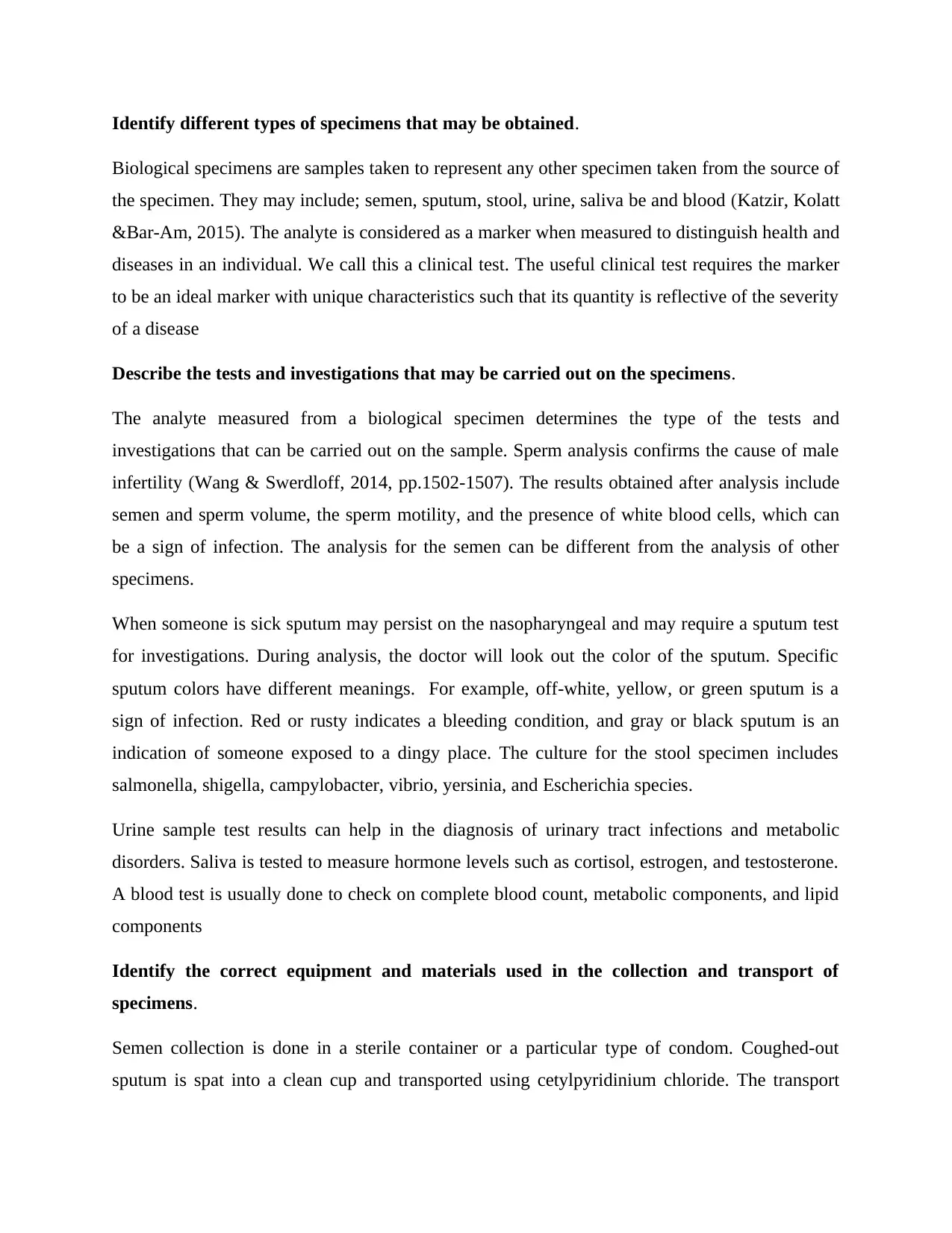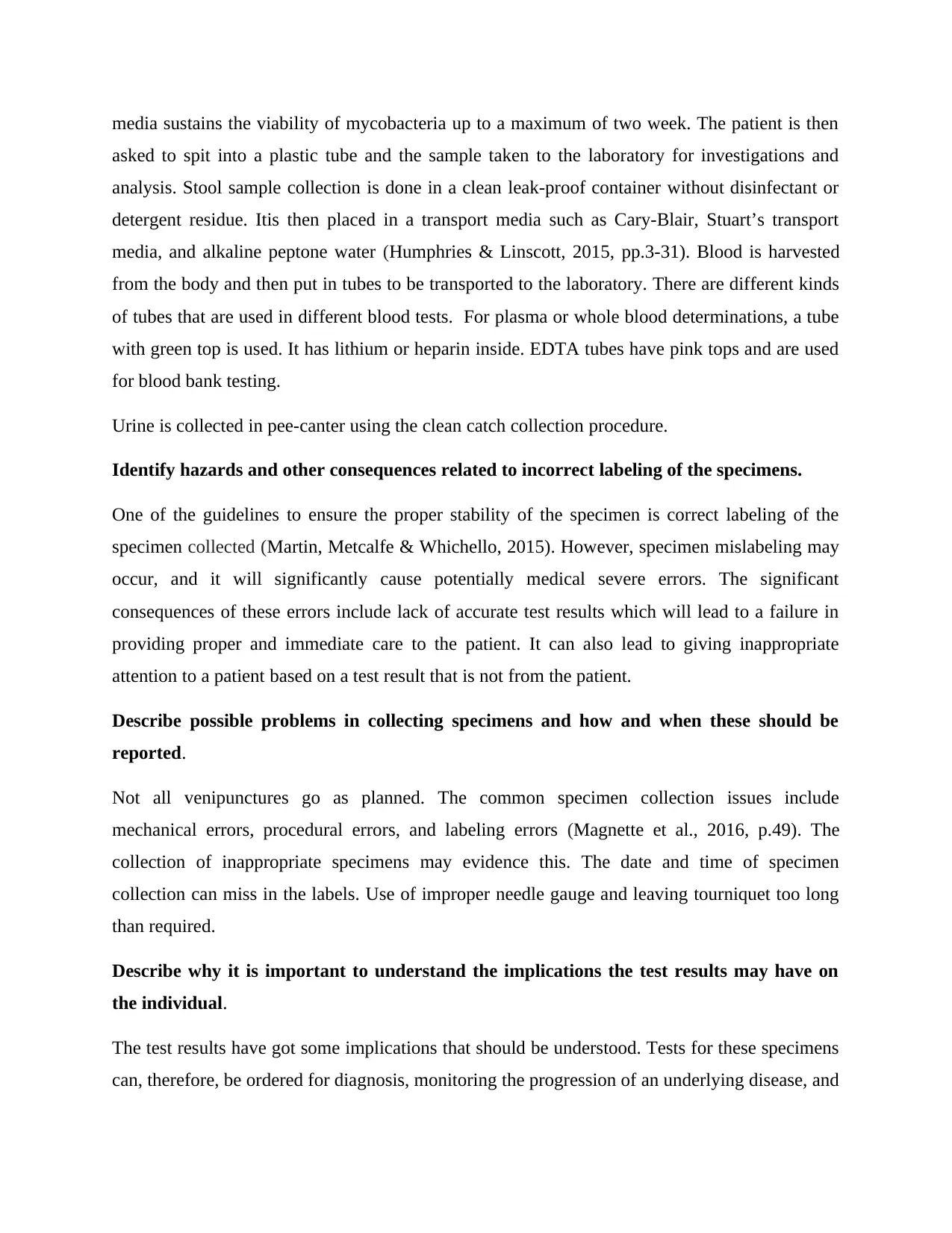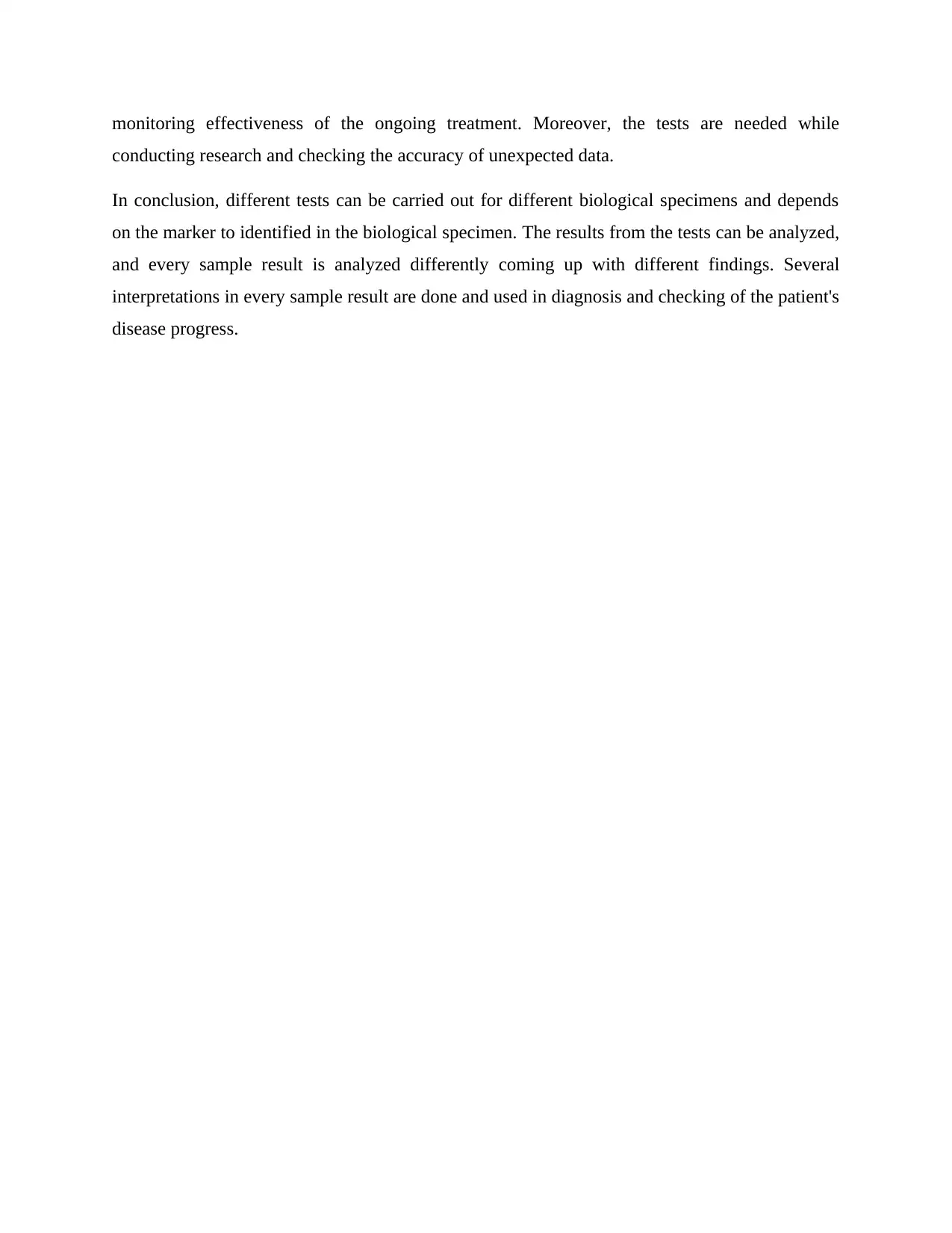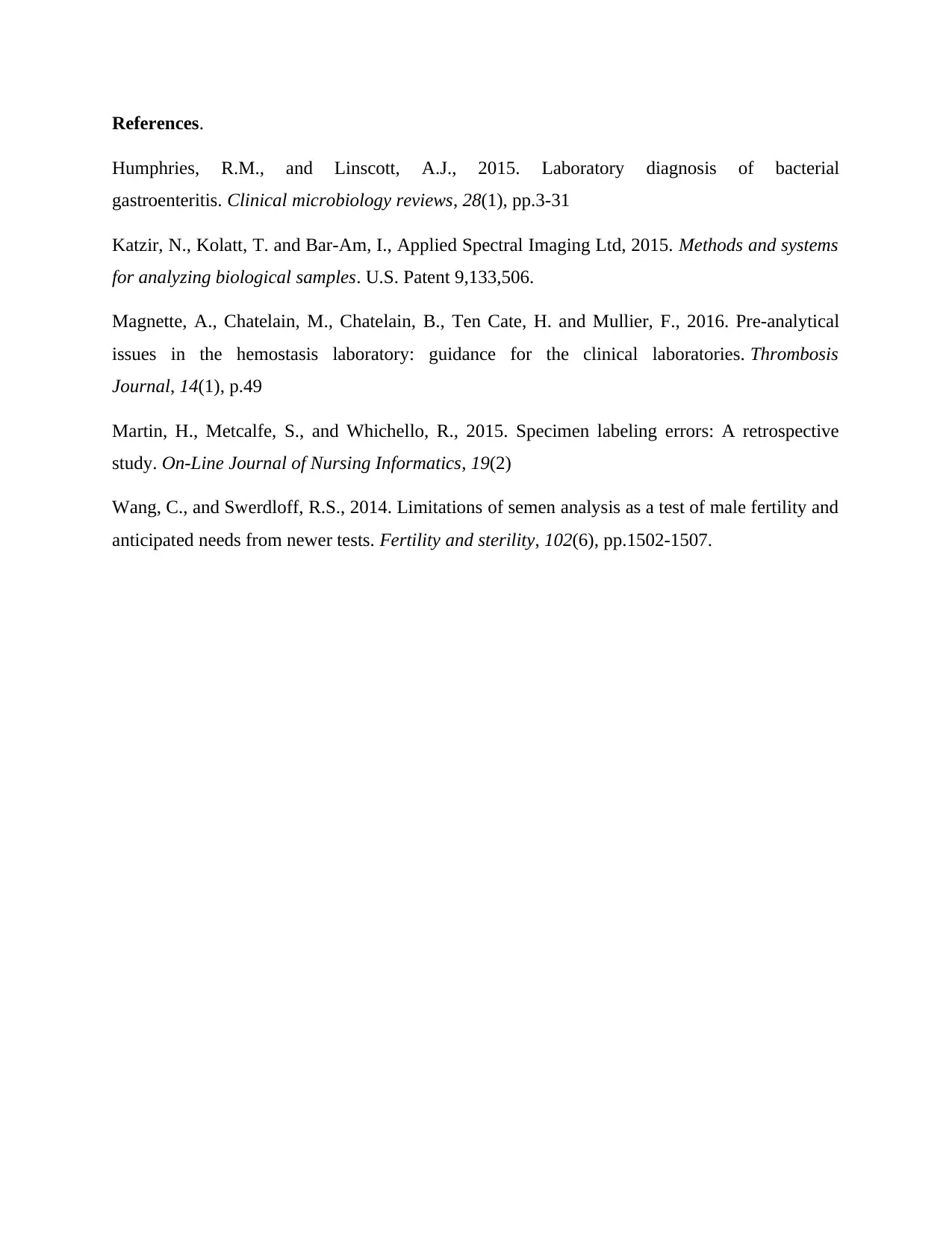Comprehensive Report: Specimen Collection, Analysis, and Implications
VerifiedAdded on 2022/11/25
|5
|1089
|132
Report
AI Summary
This report examines the process of obtaining and testing various biological specimens, including semen, sputum, stool, urine, saliva, and blood. It details the types of tests and investigations conducted on each specimen, such as sperm analysis, sputum analysis, stool culture, urine analysis, saliva hormone level measurement, and blood tests. The report also identifies the correct equipment and materials used for specimen collection and transport, emphasizing the importance of proper labeling to avoid medical errors. It discusses potential problems in specimen collection, including mechanical, procedural, and labeling errors, and explains the significance of understanding the implications of test results for diagnosis, disease monitoring, treatment effectiveness, and research. The report concludes by highlighting the importance of accurate analysis and interpretation of results for patient care and disease progression assessment.

Student name;
Institutional affiliation;
Institutional affiliation;
Paraphrase This Document
Need a fresh take? Get an instant paraphrase of this document with our AI Paraphraser

Identify different types of specimens that may be obtained.
Biological specimens are samples taken to represent any other specimen taken from the source of
the specimen. They may include; semen, sputum, stool, urine, saliva be and blood (Katzir, Kolatt
&Bar-Am, 2015). The analyte is considered as a marker when measured to distinguish health and
diseases in an individual. We call this a clinical test. The useful clinical test requires the marker
to be an ideal marker with unique characteristics such that its quantity is reflective of the severity
of a disease
Describe the tests and investigations that may be carried out on the specimens.
The analyte measured from a biological specimen determines the type of the tests and
investigations that can be carried out on the sample. Sperm analysis confirms the cause of male
infertility (Wang & Swerdloff, 2014, pp.1502-1507). The results obtained after analysis include
semen and sperm volume, the sperm motility, and the presence of white blood cells, which can
be a sign of infection. The analysis for the semen can be different from the analysis of other
specimens.
When someone is sick sputum may persist on the nasopharyngeal and may require a sputum test
for investigations. During analysis, the doctor will look out the color of the sputum. Specific
sputum colors have different meanings. For example, off-white, yellow, or green sputum is a
sign of infection. Red or rusty indicates a bleeding condition, and gray or black sputum is an
indication of someone exposed to a dingy place. The culture for the stool specimen includes
salmonella, shigella, campylobacter, vibrio, yersinia, and Escherichia species.
Urine sample test results can help in the diagnosis of urinary tract infections and metabolic
disorders. Saliva is tested to measure hormone levels such as cortisol, estrogen, and testosterone.
A blood test is usually done to check on complete blood count, metabolic components, and lipid
components
Identify the correct equipment and materials used in the collection and transport of
specimens.
Semen collection is done in a sterile container or a particular type of condom. Coughed-out
sputum is spat into a clean cup and transported using cetylpyridinium chloride. The transport
Biological specimens are samples taken to represent any other specimen taken from the source of
the specimen. They may include; semen, sputum, stool, urine, saliva be and blood (Katzir, Kolatt
&Bar-Am, 2015). The analyte is considered as a marker when measured to distinguish health and
diseases in an individual. We call this a clinical test. The useful clinical test requires the marker
to be an ideal marker with unique characteristics such that its quantity is reflective of the severity
of a disease
Describe the tests and investigations that may be carried out on the specimens.
The analyte measured from a biological specimen determines the type of the tests and
investigations that can be carried out on the sample. Sperm analysis confirms the cause of male
infertility (Wang & Swerdloff, 2014, pp.1502-1507). The results obtained after analysis include
semen and sperm volume, the sperm motility, and the presence of white blood cells, which can
be a sign of infection. The analysis for the semen can be different from the analysis of other
specimens.
When someone is sick sputum may persist on the nasopharyngeal and may require a sputum test
for investigations. During analysis, the doctor will look out the color of the sputum. Specific
sputum colors have different meanings. For example, off-white, yellow, or green sputum is a
sign of infection. Red or rusty indicates a bleeding condition, and gray or black sputum is an
indication of someone exposed to a dingy place. The culture for the stool specimen includes
salmonella, shigella, campylobacter, vibrio, yersinia, and Escherichia species.
Urine sample test results can help in the diagnosis of urinary tract infections and metabolic
disorders. Saliva is tested to measure hormone levels such as cortisol, estrogen, and testosterone.
A blood test is usually done to check on complete blood count, metabolic components, and lipid
components
Identify the correct equipment and materials used in the collection and transport of
specimens.
Semen collection is done in a sterile container or a particular type of condom. Coughed-out
sputum is spat into a clean cup and transported using cetylpyridinium chloride. The transport

media sustains the viability of mycobacteria up to a maximum of two week. The patient is then
asked to spit into a plastic tube and the sample taken to the laboratory for investigations and
analysis. Stool sample collection is done in a clean leak-proof container without disinfectant or
detergent residue. Itis then placed in a transport media such as Cary-Blair, Stuart’s transport
media, and alkaline peptone water (Humphries & Linscott, 2015, pp.3-31). Blood is harvested
from the body and then put in tubes to be transported to the laboratory. There are different kinds
of tubes that are used in different blood tests. For plasma or whole blood determinations, a tube
with green top is used. It has lithium or heparin inside. EDTA tubes have pink tops and are used
for blood bank testing.
Urine is collected in pee-canter using the clean catch collection procedure.
Identify hazards and other consequences related to incorrect labeling of the specimens.
One of the guidelines to ensure the proper stability of the specimen is correct labeling of the
specimen collected (Martin, Metcalfe & Whichello, 2015). However, specimen mislabeling may
occur, and it will significantly cause potentially medical severe errors. The significant
consequences of these errors include lack of accurate test results which will lead to a failure in
providing proper and immediate care to the patient. It can also lead to giving inappropriate
attention to a patient based on a test result that is not from the patient.
Describe possible problems in collecting specimens and how and when these should be
reported.
Not all venipunctures go as planned. The common specimen collection issues include
mechanical errors, procedural errors, and labeling errors (Magnette et al., 2016, p.49). The
collection of inappropriate specimens may evidence this. The date and time of specimen
collection can miss in the labels. Use of improper needle gauge and leaving tourniquet too long
than required.
Describe why it is important to understand the implications the test results may have on
the individual.
The test results have got some implications that should be understood. Tests for these specimens
can, therefore, be ordered for diagnosis, monitoring the progression of an underlying disease, and
asked to spit into a plastic tube and the sample taken to the laboratory for investigations and
analysis. Stool sample collection is done in a clean leak-proof container without disinfectant or
detergent residue. Itis then placed in a transport media such as Cary-Blair, Stuart’s transport
media, and alkaline peptone water (Humphries & Linscott, 2015, pp.3-31). Blood is harvested
from the body and then put in tubes to be transported to the laboratory. There are different kinds
of tubes that are used in different blood tests. For plasma or whole blood determinations, a tube
with green top is used. It has lithium or heparin inside. EDTA tubes have pink tops and are used
for blood bank testing.
Urine is collected in pee-canter using the clean catch collection procedure.
Identify hazards and other consequences related to incorrect labeling of the specimens.
One of the guidelines to ensure the proper stability of the specimen is correct labeling of the
specimen collected (Martin, Metcalfe & Whichello, 2015). However, specimen mislabeling may
occur, and it will significantly cause potentially medical severe errors. The significant
consequences of these errors include lack of accurate test results which will lead to a failure in
providing proper and immediate care to the patient. It can also lead to giving inappropriate
attention to a patient based on a test result that is not from the patient.
Describe possible problems in collecting specimens and how and when these should be
reported.
Not all venipunctures go as planned. The common specimen collection issues include
mechanical errors, procedural errors, and labeling errors (Magnette et al., 2016, p.49). The
collection of inappropriate specimens may evidence this. The date and time of specimen
collection can miss in the labels. Use of improper needle gauge and leaving tourniquet too long
than required.
Describe why it is important to understand the implications the test results may have on
the individual.
The test results have got some implications that should be understood. Tests for these specimens
can, therefore, be ordered for diagnosis, monitoring the progression of an underlying disease, and
⊘ This is a preview!⊘
Do you want full access?
Subscribe today to unlock all pages.

Trusted by 1+ million students worldwide

monitoring effectiveness of the ongoing treatment. Moreover, the tests are needed while
conducting research and checking the accuracy of unexpected data.
In conclusion, different tests can be carried out for different biological specimens and depends
on the marker to identified in the biological specimen. The results from the tests can be analyzed,
and every sample result is analyzed differently coming up with different findings. Several
interpretations in every sample result are done and used in diagnosis and checking of the patient's
disease progress.
conducting research and checking the accuracy of unexpected data.
In conclusion, different tests can be carried out for different biological specimens and depends
on the marker to identified in the biological specimen. The results from the tests can be analyzed,
and every sample result is analyzed differently coming up with different findings. Several
interpretations in every sample result are done and used in diagnosis and checking of the patient's
disease progress.
Paraphrase This Document
Need a fresh take? Get an instant paraphrase of this document with our AI Paraphraser

References.
Humphries, R.M., and Linscott, A.J., 2015. Laboratory diagnosis of bacterial
gastroenteritis. Clinical microbiology reviews, 28(1), pp.3-31
Katzir, N., Kolatt, T. and Bar-Am, I., Applied Spectral Imaging Ltd, 2015. Methods and systems
for analyzing biological samples. U.S. Patent 9,133,506.
Magnette, A., Chatelain, M., Chatelain, B., Ten Cate, H. and Mullier, F., 2016. Pre-analytical
issues in the hemostasis laboratory: guidance for the clinical laboratories. Thrombosis
Journal, 14(1), p.49
Martin, H., Metcalfe, S., and Whichello, R., 2015. Specimen labeling errors: A retrospective
study. On-Line Journal of Nursing Informatics, 19(2)
Wang, C., and Swerdloff, R.S., 2014. Limitations of semen analysis as a test of male fertility and
anticipated needs from newer tests. Fertility and sterility, 102(6), pp.1502-1507.
Humphries, R.M., and Linscott, A.J., 2015. Laboratory diagnosis of bacterial
gastroenteritis. Clinical microbiology reviews, 28(1), pp.3-31
Katzir, N., Kolatt, T. and Bar-Am, I., Applied Spectral Imaging Ltd, 2015. Methods and systems
for analyzing biological samples. U.S. Patent 9,133,506.
Magnette, A., Chatelain, M., Chatelain, B., Ten Cate, H. and Mullier, F., 2016. Pre-analytical
issues in the hemostasis laboratory: guidance for the clinical laboratories. Thrombosis
Journal, 14(1), p.49
Martin, H., Metcalfe, S., and Whichello, R., 2015. Specimen labeling errors: A retrospective
study. On-Line Journal of Nursing Informatics, 19(2)
Wang, C., and Swerdloff, R.S., 2014. Limitations of semen analysis as a test of male fertility and
anticipated needs from newer tests. Fertility and sterility, 102(6), pp.1502-1507.
1 out of 5
Your All-in-One AI-Powered Toolkit for Academic Success.
+13062052269
info@desklib.com
Available 24*7 on WhatsApp / Email
![[object Object]](/_next/static/media/star-bottom.7253800d.svg)
Unlock your academic potential
Copyright © 2020–2025 A2Z Services. All Rights Reserved. Developed and managed by ZUCOL.


